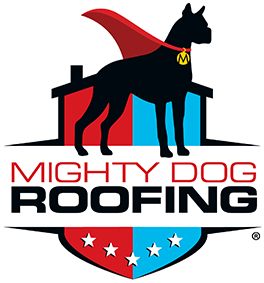The 13 Most Common Types of Roof Damage
Table of Contents
- #1: Hail Damage
- #2: Wind Damage
- #3: Moss Damage
- #4: UV and Heat Damage
- #5: Water Damage
- #6: Ice Damage
- #7: Structural Damage
- #8: Tree Damage
- #9: Pest Damage
- #10: Mechanical Damage
- #11: Flashing Damage
- #12: Snow Damage
- #13: Malicious Roof Damage
Want to keep your home safe, dry, and protected? It starts with a healthy roof. But how do you know if your roof is at risk? This guide is your answer.
We'll explore the 13 most common types of roof damage, empowering you to identify problems early and prevent costly repairs. Get ready to become a roof-savvy homeowner!
#1. Hail Damage

A professional residential roofer should always inspect your roof for damage after a hailstorm.
Hail damage can manifest as small dark spots on asphalt shingles or larger cracks on cedar shake roofs, and may prove harder to identify on some metal or synthetic roofs.
Do you see dents or scratches elsewhere on the property, like mailboxes, cars, roof flashing, or vents? If so, your roof may have suffered damage, too. Hail damage can also compromise shingle granules, making the roof susceptible to UV rays and water intrusion, leading to leaks that require urgent roof repair.
Minor repairs may suffice in most cases, but you should consider replacing their roof if you can find more than eight roof damage spots per 100 square feet. Choosing roofing materials that can withstand high impact can help prevent hail damage in the future. A roofer can help you choose the right shingles!
Thicker asphalt shingles with extra tabs or layers and synthetic roofing engineered for impact resistance are two of the best options, especially in areas prone to severe storm damage.
#2. Wind Damage
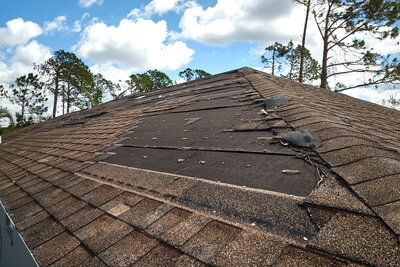
Tornadoes blow through the Midwest and other parts of the United States yearly. Furthermore, strong wind gusts can cause roof damage even on your average windy day.
Wind damage shows up as tears, cracks, curled corners, or missing shingles. Damaged shingles make your roof more vulnerable to water damage.
Installing a roofing material with a high wind rating will minimize roof damage. However, preventing wind damage proves impossible. Even the best roof materials can fail due to poor installation, which is the leading cause of wind damage.
Fortunately, fixing roof damage from strong winds is pretty straightforward. Generally, replacing a few shingles can restore your roof. Don't delay, though. Neglecting to fix shingles exposes your roof to the elements, which may necessitate a premature roof replacement.
#3. Moss Damage
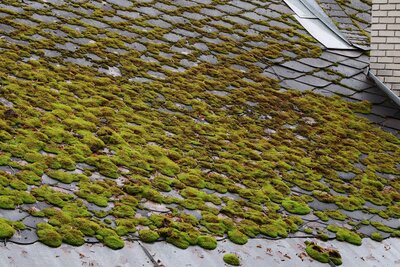
Moss may cause roof damage as it grows on the shingles. It appears as clumps of green all over the entire roof or in a few sections. If the moss established itself long ago, homeowners should get the affected shingles replaced by skilled roofers.
Moisture problems may develop if the roof sits in a shady area or if you neglect proper gutter cleaning. Lack of proper maintenance and poor drainage will lead to moss and lichen growth on an older roof. Sometimes, the growth remains only on the surface. But it can also grow underneath the shingles and damage the plywood decking.
This type of damage weakens the roof and makes it more vulnerable to water and heat damage. Roofing experts may trim trees that create excessive shade to prevent moss roof damage. Besides tree trimming, keeping the gutters free from debris like sticks, leaves, and loose granules will ensure proper water drainage.
You should promptly address fungus or moss growing on your roof. Experts may remove superficial patches of moss using gloves and scouring pads. In some cases, they may need to remove old materials and replace them if the fungus becomes toxic or it has already caused extensive damage.
Do you have moss on your roof? Learn how to safely and effectively remove moss from your roof in our blog. For general roof cleaning tips, check out our guide on how to clean roof shingles.
#4. UV and Heat Damage
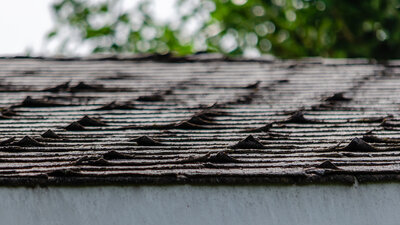
A close inspection may reveal heat blisters—bubbles or holes on the shingle’s surface—due to constant sun exposure, making the roof more susceptible to UV damage. Roofs damaged by heat or UV rays may exhibit warped, buckling shingles.
A roofing company may replace shingles that lack granules, as granules act as a protective layer to prevent UV damage. Areas with missing granules from recent impacts prove especially vulnerable to heat damage, causing asphalt warping, potential leaks, and high energy bills.
Visual inspection from the ground using binoculars can identify issues like curling edges, cracks, or gaps. However, hiring an expert roofer for a closer examination is highly recommended.
Improper roof ventilation may lead to heat damage. Signs of UV damage include warped shingles and excessive heat near the building’s top level. Improving ventilation with better roof vents or an attic fan will enhance airflow.
Have extreme temperatures damaged the roof? We recommend scheduling a thorough roofing inspection. A professional roofer can review roof repair or replacement options. They can also recommend ventilation improvements.
#5. Water Damage
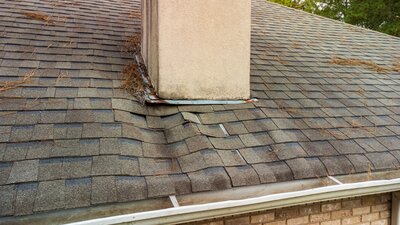
Your roof protects you from rain and other types of precipitation. However, seeping water can cause further damage over time and destroy underlying materials. You should hire skilled roofers to repair all water-damaged shingles to prevent leaks and further roof damage.
Wood and water do not mix well. The longer a leak goes unresolved, the more it deteriorates the roof condition, eventually affecting other parts of the house.
Sometimes, it is challenging to spot water damage without a thorough inspection. Furthermore, water can damage more than just the roof. If a hole is left alone, water may seep into the walls, leading to mold and moisture problems.
Some of the most noticeable roof leak indicators include:
- Water dripping from the ceiling, particularly during storms
- Dark spots appearing on the ceiling
- Dips or sags in shingles
Do you have a roof leak? A roofing contractor can usually repair the affected area. Other times, building owners may have to replace the entire roof decking, underlayment, and shingles if the leaks go untreated.
#6. Ice Damage
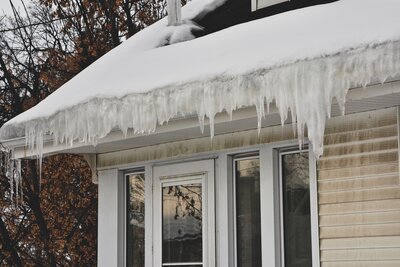
Buildings with large icicles or sheets of ice along the roof’s edge may have ice dams.
Interior heat might create a risk by melting snow, which collects behind an ice dam hidden beneath thick snow layers. The trapped water may lead to significant roof damage, including leaks that spread into the walls and electrical systems.
When addressing ice dams, roof experts avoid using salt because it might do more harm than good. Instead, they use calcium chloride to melt the ice without causing any additional damage. Since it poses a potential danger of collapse to people residing in the building, it remains advisable to have professional roofers remove all ice dams.
The main risk of ice dams involves their interference with proper water drainage, blocking melted ice from flowing to the gutters after heavy snowfall. Preventing ice dams requires removing snow from roof eaves and ensuring proper ventilation to promote even snow melting.
#7. Structural Damage
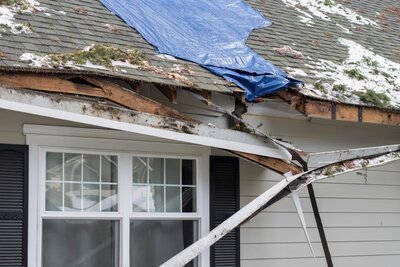
Structural damage to the roof, indicated by holes or collapse after a storm, requires quick professional attention.
Subtle signs like sagging or bending shingles and decking may signal underlying structural issues, necessitating immediate repair.
After detecting structural roof damage, swift repairs can prevent water leaks and even more severe structural problems. Homeowners should consult their insurance company regarding coverage before getting an estimate for repairs or full replacement and filing an insurance claim.
The fascia, soffit, and plywood decking remain susceptible to damage from rain and heat over time. The outermost layer, shingles, protects the roof from the elements, but storms, high winds, and aging can make them loose, cracked, or missing.
When damage to these roof parts compromises the entire structure, a full roof replacement is in order.
#8. Tree Damage

Addressing tree damage immediately after it occurs will prevent further issues and ensure roof safety and functionality.
Tree damage can happen without strong gusts of wind. Falling branches and fruit can create a noticeable impact. If a tree branch falls on the roof, an inspection becomes imperative. Ask a professional roofer to check for granule dislodgment or tears in the shingles.
During storms, tree damage poses an acute risk, with high winds blowing branches or entire trees onto roofs, causing severe damage. Tree impacts may lead to issues similar to hail damage, such as cracked shingles, or catastrophic loss of structural integrity.
Large limbs or entire trees often cause structural roof damage, affecting the decking and frame. In such cases, you should seek help from a professional roofing company for the necessary repairs or replacement.
#9. Pest Damage

Roof pest damage can affect the roof structure and pose several health risks.
Trimming your trees and keeping a neat yard will protect a roof from pests because it will limit their hiding spots. Hiring an exterminator as part of your routine roofing maintenance will address potential entry points and prevent pest infestations.
Pests like rats, squirrels, or raccoons wreak havoc by chewing holes near the ridge or roof edge, often visible from the ground. Termites and carpenter bees pose a threat to untreated wood. Bees, wasps, and hornets can harm fascia and soffits by attaching nests to the roof’s overhang.
Pest damage weakens the roof, making it more susceptible to additional harm from water or mold. Seek swift professional assistance when common signs of a pest infestation are detected. Merely repairing the roof without addressing the infestation is ineffective.
#10. Mechanical Damage
Working with a trained roof installer is crucial to avoid mechanical damage problems. Improper installation practices, like missing nails and uneven material placement, may lead to unintentional roof damage. These accidents make a home prone to severe damage.
Roofs can sustain damage from human activities like cleaning gutters, shoveling snow, or walking on steep asphalt roofs in hot weather. Signs of damage may appear as loose or cracked shingles, missing granules, and dark spots.
Some common problem areas include:
- Chimneys
- Valleys
- Skylights
- Rakes
- Walls
#11. Flashing Damage

Roof flashing is the metal used to seal valleys and roof penetrations, safeguarding a building against rain and snow.
While damaged flashing may not always require immediate attention, roof experts recommend promptly inspecting the roof before making repairs. Installing high-quality flashing in the first place can stave off repairs and replacements for a little longer.
Even seemingly minor damage might lead to significant issues. Rust or hail damage can also affect roof flashing. Roofers may suggest replacing damaged flashing and adjacent shingles for lasting repairs. Homeowners should avoid temporary fixes like adding caulk.
#12. Snow Damage
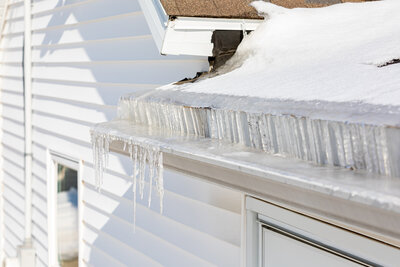
Snow poses several risks to older roofs.
Your roof’s slope is designed to facilitate water runoff, but blocked gutters or ice dams can prevent the directed melt flow. Melting snow’s overflow and subsequent freezing can damage the attic, ceilings, walls, and roof.
Excess snow accumulation can weaken the roof structure, especially flat or poorly designed roofs that do not shed snow well. Any hole in the roof allows melted ice to enter and cause water damage. Heavy snow on old roofs may lead to significant damage or even collapse.
Water leaks may occur with damaged shingles or gaps around features like chimneys, flashing, or skylights. Roofing experts often use roof rakes to remove snow after heavy snowfall to prevent roof damage and accidents.
#13. Malicious Roof Damage
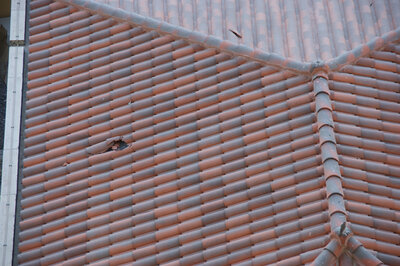
While we often think of storms or age as the culprits, malicious roof damage is a real threat.
Malicious roof damage is intentional damage caused by third-party vandalism or mischief. It's definitely frustrating, but here's what you need to know.
Spotting Malicious Roof Damage
It can be tricky to tell accidental damage from vandalism, but look for these red flags:
- Weird Patterns. Does your roof damage look sporadic? Damage that doesn't look natural or is accompanied by graffiti is likely vandalism.
- Isolated Damage. Damage in one spot without other signs of wear or weather-related issues.
- Signs of Trespassing. Investigate your property to look for evidence of trespassing.
- Neighbor Intel. Ask your neighbors if they have noticed anything suspicious.
Does Insurance Cover Malicious Roof Damage?
The good news is that your homeowners insurance policy should cover malicious mischief or vandalism to your roof.
But there are a few things to keep in mind:
- Third-Party Vandalism. Most policies only cover third-party roof damage. This means your malicious roof damage won't be covered if someone living in your home caused the damage.
- Check Your Policy. Always review your policy to know your exact coverage and any exclusions.
- Call Your Agent. It's wise to chat with your insurance agent for their advice.
Dealing with malicious roof damage can be stressful. However, understanding your insurance coverage and taking prompt action can help prevent more roof damage.
Don't Let Roof Damage Linger: Your Free Inspection Is a Call Away!
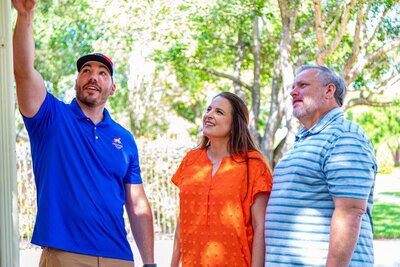
Did your house suffer roof damage during the last storm? We provide 24-hour emergency roof repair if you need immediate assistance.
At Mighty Dog Roofing, our team of seasoned professionals has a solid track record, having completed hundreds of repair projects to address various types of roof damage.
We understand the importance of a secure and sturdy roof over your head, and our dedicated roofers are equipped with the expertise and tools necessary to ensure your roof is in top condition.
Need help today? Contact your local Mighty Dog Roofing today. Or dial (833) MIGHTY 4 for a free consultation today!
